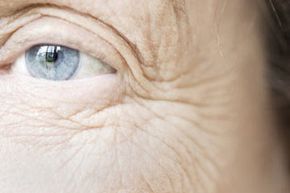You can call crow's feet "laugh lines" or "character lines," but these slightly more flattering terms still refer to the same, inevitable sign of aging: the wrinkles that begin to form at the outside corners of your eyes when you hit your mid-twenties. They may show up earlier for people who don't take good care of their skin and later for those who do. But either way, crow's feet are all but unavoidable.
The skin on our faces stretches like a rubber band, thanks to a property called elasticity. This means that it can return to its original form after being pulled or compressed -- pretty important when you think about how much we move our faces. Unfortunately, as we get older, our skin loses its elasticity. That's why we form wrinkles and certain parts of our body start to droop. One of the main reasons for this is that our bodies' production of collagen and elastin, two proteins responsible for our skin's elasticity, lessens with age [source: AAD: Aging Skin, MayoClinic:Wrinkles].
Advertisement
One way to avoid crow's feet would be to never smile, laugh, frown or squint. Since that seems next to impossible, most of us have to look into other ways of fending off those v-shaped wrinkles. For starters, you can protect yourself from the sun's harmful UV rays by using sunscreen. Exposure to UV rays is one of the most common ways our skin loses collagen and elastin, and ultimately, its ability to bounce back. If you're a smoker, you're even more at risk. Smoking kick-starts the biochemical processes that cause your skin to age faster [source: AAD: Aging Skin].
That being said, you can put on sunscreen every day, never touch a cigarette and still get crow's feet. But there are a number of ways to reduce their appearance. Read on to find out how.
Advertisement
